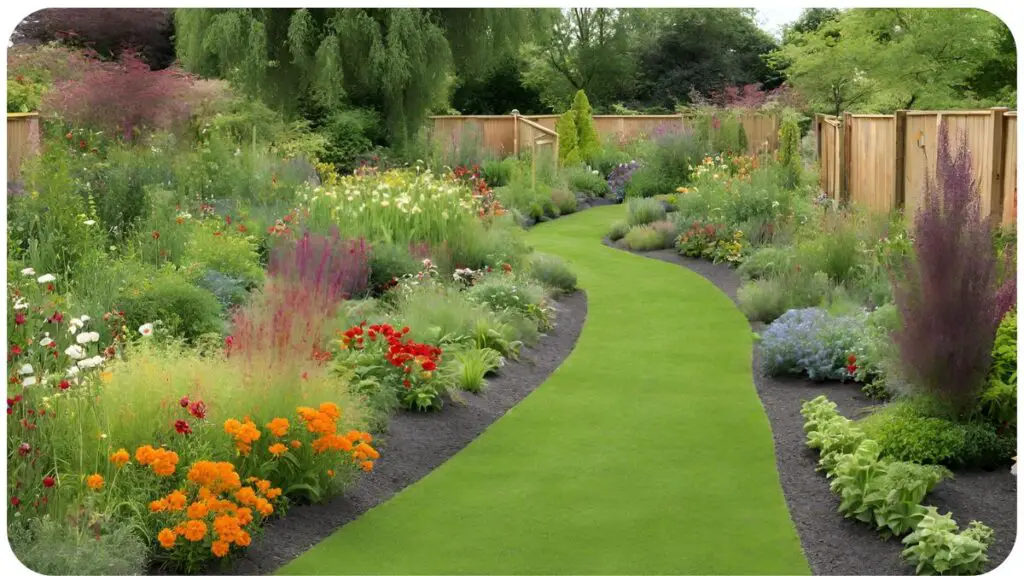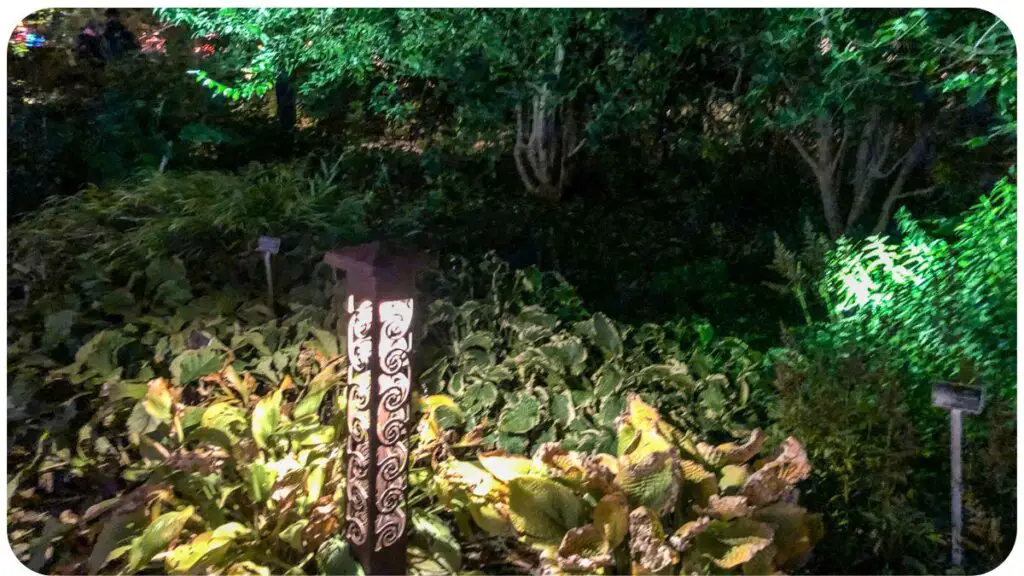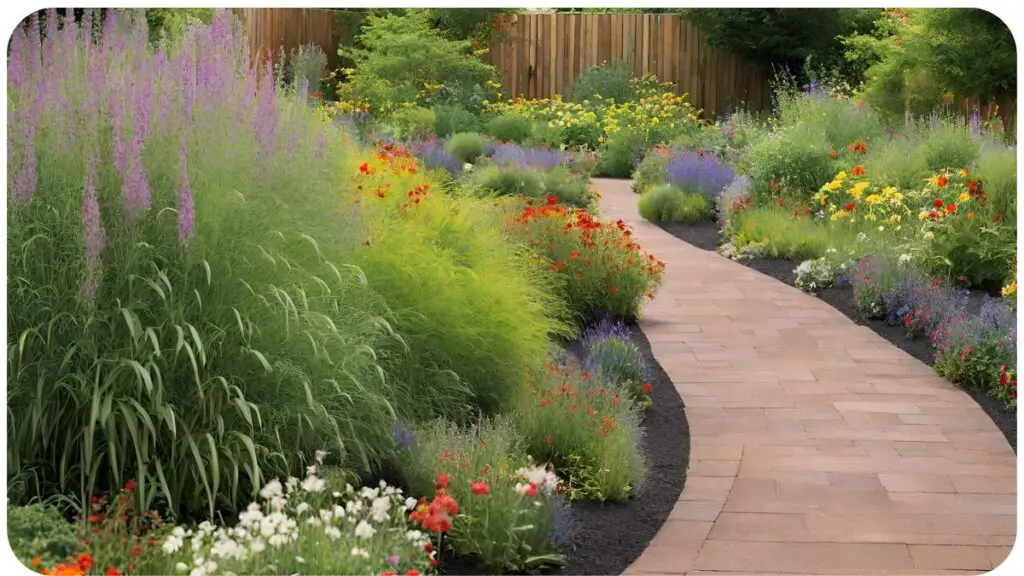Welcome to the world of sensory gardens! While many people enjoy the beauty of gardens during daylight hours, there’s a whole other experience waiting to be explored after the sun sets.
In this article, we’ll delve into the concept of cultivating a sensory garden after dark. From understanding the fundamentals to practical tips for designing and maintaining your nighttime oasis, we’ll cover it all.
| Key Takeaways |
|---|
| 1. Engage all five senses with plant selection. |
| 2. Incorporate fragrant flowers and herbs. |
| 3. Create texture with a variety of foliage. |
| 4. Include elements for soothing sounds. |
| 5. Design paths for exploration and discovery. |
| 6. Use lighting to enhance the nighttime experience. |
| 7. Provide seating for relaxation and contemplation. |
| 8. Consider the needs of wildlife visitors. |
| 9. Incorporate water features for auditory and visual interest. |
| 10. Utilize raised beds or containers for accessibility. |
| 11. Incorporate edible plants for taste stimulation. |
| 12. Personalize your sensory garden to reflect your unique preferences and personality. |
2. Understanding Sensory Gardens
Before diving into the specifics of nighttime gardening, let’s establish what sensory gardens are all about. A sensory garden is designed to stimulate the senses, providing a multi-dimensional experience for visitors. These gardens are carefully curated to engage sight, smell, touch, taste, and even sound, creating a holistic sensory journey.
Harness the power of lunar cycles to maximize plant growth in your garden. By aligning planting and care routines with lunar phases, you can optimize plant health and yield naturally, fostering a harmonious relationship between your garden and the cosmos.
3. Benefits of a Sensory Garden

The benefits of sensory gardens extend beyond mere aesthetics. Research has shown that spending time in nature can have a positive impact on mental well-being, reducing stress and anxiety. Additionally, sensory gardens provide opportunities for sensory stimulation, which can be particularly beneficial for individuals with sensory processing disorders or cognitive impairments.
Table: Benefits of a Sensory Garden
| Benefit | Description |
|---|---|
| Stress Reduction | Spending time in a sensory garden can promote relaxation and reduce stress levels. |
| Therapeutic Benefits | Sensory gardens offer therapeutic benefits, particularly for individuals with sensory disorders. |
| Cognitive Stimulation | Engaging the senses can help stimulate cognitive function and improve mental clarity. |
| Community Engagement | Sensory gardens provide a space for community members to come together and connect with nature. |
4. Designing Your Sensory Garden
Creating a sensory garden that shines after dark requires careful planning and consideration. From selecting the right plants to incorporating elements that enhance the nighttime experience, every aspect plays a crucial role in crafting a captivating space.
Choosing Plants
When it comes to selecting plants for your sensory garden, opt for varieties that excel in the evening hours. Look for species with fragrant flowers or foliage that release their scent after dusk. Lavender, jasmine, and night-blooming flowers like moonflower and evening primrose are excellent choices. Additionally, consider plants with interesting textures and foliage that can be appreciated through touch.
Delve into the intricate world of the garden microbiome to unlock the secrets of healthier plants. Understanding and nurturing the microbial community in your soil can lead to improved nutrient uptake, disease resistance, and overall garden vitality, creating an ecosystem where plants thrive.
Creating Pathways
Pathways are not only practical for navigating your garden but also add to the overall ambiance. Opt for materials that reflect light, such as gravel or pale-colored stones, to increase visibility in the dark. Incorporate curves and bends in your pathways to create a sense of discovery and intrigue as visitors explore your garden.
Incorporating Lighting
Lighting plays a pivotal role in transforming your sensory garden into a nighttime oasis. Experiment with different lighting options, such as solar-powered lanterns, string lights, or strategically placed spotlights. Consider using warm, soft lighting to create a cozy atmosphere while highlighting key features of your garden, such as blooming flowers or sculptural elements.
Transform your garden into a lush oasis with these budget-friendly hacks. Discover innovative strategies for maximizing space, utilizing recycled materials, and minimizing expenses without compromising on beauty or functionality, allowing you to create a stunning garden retreat on a dime.
Table: Plants for a Sensory Garden
| Type | Description |
|---|---|
| Fragrant Flowers | Species with fragrant flowers like lavender, jasmine, and night-blooming flowers. |
| Textural Plants | Plants with interesting textures and foliage, such as lamb’s ear or ferns. |
| Night-Blooming | Flowers that open at night, such as moonflower, evening primrose, or angel’s trumpet. |
Table: Pathway Materials
| Material | Description |
|---|---|
| Gravel | Provides good drainage and reflects light for increased visibility. |
| Pale-colored Stones | Adds texture and contrast while reflecting light. |
| Pavers | Durable and easy to maintain, available in various colors and styles. |
Table: Lighting Options
| Lighting Option | Description |
|---|---|
| Solar-powered Lanterns | Environmentally friendly and easy to install, providing soft, ambient lighting. |
| String Lights | Create a magical atmosphere with twinkling lights strung along pathways or trellises. |
| Spotlights | Illuminate specific features of your garden, such as sculptures or focal plants, for emphasis. |
Now that we’ve covered the essentials of designing a sensory garden, let’s explore how to enhance the nighttime experience for visitors.
5. Enhancing the Nighttime Experience

To truly captivate visitors after dark, it’s essential to focus on elements that heighten the sensory experience. From fragrant blooms to soothing sounds, each component contributes to creating an enchanting atmosphere.
Turn kitchen scraps into nutrient-rich gold for your garden with these simple tips. By composting organic waste, you can enrich your soil, reduce landfill waste, and promote sustainability while providing your plants with the essential nutrients they need to thrive and flourish.
Fragrant Flowers and Herbs
Fragrance plays a significant role in nighttime gardens, where it can be more pronounced in the cooler air. Incorporate fragrant flowers and herbs strategically throughout your garden to delight the olfactory senses. Consider planting varieties like lavender, rosemary, and honeysuckle near pathways or seating areas where visitors can enjoy their scent up close.
Textures and Surfaces
Textures add depth and interest to your sensory garden, especially under the cover of darkness. Incorporate a variety of textures, from soft, velvety leaves to rough bark and smooth stones. Plants like lamb’s ear and ferns provide tactile experiences, while decorative elements like sculptures or water features add visual and textural interest.
Soundscapes
Sound can enhance the ambiance of your sensory garden, creating a tranquil and immersive environment. Integrate elements that produce soothing sounds, such as wind chimes, gently flowing water, or rustling foliage. These auditory cues can evoke feelings of calm and relaxation, further enhancing the sensory experience.
Visual Elements
While the darkness of night may obscure some visual details, there are still opportunities to engage the sense of sight in your garden. Choose plants with foliage that contrasts well against the night sky, such as variegated leaves or plants with silver or white markings. Additionally, incorporate reflective surfaces like glass ornaments or metallic sculptures to catch and amplify any available light.
Table: Fragrant Flowers and Herbs
| Plant | Fragrance Description |
|---|---|
| Lavender | Sweet, floral aroma with herbal undertones. |
| Rosemary | Woody, aromatic scent reminiscent of pine. |
| Honeysuckle | Sweet, intoxicating fragrance with floral notes. |
| Jasmine | Rich, floral scent that intensifies at night. |
Table: Textural Plants
| Plant | Texture Description |
|---|---|
| Lamb’s Ear | Soft, velvety leaves with a fuzzy texture. |
| Ferns | Delicate fronds with a feathery texture. |
| Succulents | Thick, fleshy leaves with a smooth surface. |
| Ornamental Grasses | Narrow blades or plumes that sway in the breeze. |
Table: Soundscapes
| Element | Description |
|---|---|
| Wind Chimes | Create melodic tones as they sway in the wind. |
| Water Features | Produce soothing sounds like trickling water or bubbling fountains. |
| Rustling Foliage | Adds a natural, gentle background noise to the garden. |
| Birdsong | Attracts birds with feeders or bird-friendly plants, adding cheerful chirps to the atmosphere. |
Table: Visual Elements
| Element | Description |
|---|---|
| Variegated Plants | Leaves with contrasting colors or patterns, visible even at night. |
| Metallic Sculptures | Reflect light and add visual interest with their shiny surfaces. |
| Glass Ornaments | Catch and refract light, creating sparkling accents in the garden. |
By incorporating these elements into your sensory garden, you can create an immersive and enchanting experience that truly comes to life after dark. Now, let’s delve into practical tips for maintaining your nighttime oasis.
Add a touch of drama and intrigue to your garden with these unconventional plant choices. Explore unique and exotic species that boast striking foliage, vibrant blooms, or fascinating growth habits, elevating the aesthetic appeal of your garden and captivating the senses of all who behold it.
6. Practical Tips for Maintenance
While designing your sensory garden is a creative and rewarding endeavor, it’s essential to consider the ongoing care and maintenance required to keep it thriving. From watering to pest control, here are some practical tips to ensure your nighttime oasis remains vibrant and healthy.
Watering
Proper watering is crucial for the health of your plants, especially during the warmer months when evaporation rates are high. Water your garden deeply and infrequently to encourage deep root growth and drought resistance. Consider installing a drip irrigation system or soaker hoses to deliver water directly to the root zone while minimizing water loss through evaporation.
Pruning
Regular pruning helps maintain the shape and health of your plants while preventing overcrowding and disease. Remove dead or damaged foliage, as well as any branches that may be obstructing pathways or impeding the growth of neighboring plants. Additionally, prune back any overgrown vegetation to ensure adequate airflow and sunlight penetration throughout the garden.
Pest Control
Pests can pose a threat to your sensory garden, damaging plants and disrupting the overall balance of your ecosystem. Monitor your garden regularly for signs of pests, such as chewed leaves or sticky residue on plant surfaces. Implement natural pest control methods, such as introducing beneficial insects like ladybugs or lacewings, or using organic pesticides derived from plant-based ingredients.
Table: Watering Tips
| Tip | Description |
|---|---|
| Deep Watering | Water plants deeply to encourage deep root growth and drought resistance. |
| Mulching | Apply a layer of mulch around plants to retain moisture and suppress weeds. |
| Watering Schedule | Establish a regular watering schedule, adjusting frequency based on weather conditions. |
Table: Pruning Guidelines
| Guideline | Description |
|---|---|
| Remove Dead or Damaged Foliage | Trim away any dead or diseased leaves or branches to promote plant health. |
| Maintain Airflow | Prune back overgrown vegetation to ensure adequate airflow and sunlight penetration. |
| Shape and Structure | Trim plants to maintain their desired shape and prevent overcrowding. |
Table: Pest Control Methods
| Method | Description |
|---|---|
| Beneficial Insects | Introduce predatory insects like ladybugs or lacewings to control pest populations naturally. |
| Organic Pesticides | Use plant-based pesticides derived from natural ingredients to target specific pests while minimizing harm to beneficial insects. |
| Companion Planting | Plant pest-repellent species alongside susceptible plants to deter pests through scent or other means. |
By following these maintenance tips, you can ensure that your sensory garden remains healthy and vibrant, providing a delightful experience for visitors long after the sun has set. However, creating and maintaining a nighttime oasis isn’t without its challenges. Let’s explore some common obstacles and how to overcome them.
7. Overcoming Challenges

While cultivating a sensory garden after dark can be a rewarding experience, it’s important to be aware of potential challenges that may arise. From managing wildlife to navigating unpredictable weather, here are some strategies for overcoming obstacles and ensuring the longevity of your nighttime oasis.
Wildlife Management
Wildlife, such as deer, rabbits, or nocturnal pests like raccoons, can pose a threat to your garden by feeding on plants or causing damage to landscaping features. Implementing deterrents like fencing, motion-activated sprinklers, or natural repellents can help keep unwanted visitors at bay. Additionally, selecting plants that are less appealing to wildlife can reduce the likelihood of damage.
Weather Considerations
Weather can have a significant impact on the health and vitality of your sensory garden, particularly during extreme conditions like heatwaves or heavy rainstorms. Be proactive in protecting your plants by providing adequate shade during hot summer months and ensuring proper drainage to prevent waterlogging during periods of heavy rain. Consider investing in weather-resistant materials for pathways and landscaping features to withstand the elements.
Table: Wildlife Management Strategies
| Strategy | Description |
|---|---|
| Fencing | Install fencing around your garden to deter larger wildlife like deer or rabbits. |
| Motion-Activated Sprinklers | Use sprinklers equipped with motion sensors to startle and deter nocturnal pests. |
| Natural Repellents | Apply natural repellents like garlic or pepper spray to discourage wildlife from feeding on plants. |
Table: Weather Protection Measures
| Measure | Description |
|---|---|
| Shade Structures | Install shade sails, pergolas, or arbors to provide relief from intense sunlight during hot weather. |
| Proper Drainage | Ensure proper drainage to prevent waterlogging and root rot during heavy rainstorms. |
| Weather-Resistant Materials | Choose materials like stone or metal for pathways and landscaping features that can withstand exposure to the elements. |
By proactively addressing these challenges and implementing effective strategies, you can maintain a thriving sensory garden that continues to delight visitors long after sunset. Now, let’s conclude with some personal reflections on the joys and rewards of cultivating a sensory garden after dark.
8. Personal Reflections
As a passionate gardener and advocate for the therapeutic benefits of spending time in nature, I’ve found cultivating a sensory garden after dark to be a truly rewarding endeavor. There’s something magical about stepping into the garden as the sun dips below the horizon, and the familiar landscape transforms into a realm of mystery and enchantment.
Watching visitors explore the garden under the soft glow of moonlight or twinkling fairy lights fills me with joy, knowing that I’ve created a space where they can escape the stresses of daily life and immerse themselves in the beauty of the natural world. The scents of fragrant blooms, the rustle of leaves in the gentle breeze, and the mesmerizing play of light and shadow all contribute to a sensory experience that is both soothing and rejuvenating.
Of course, like any garden, maintaining a sensory garden after dark requires dedication and care. There are challenges to overcome, from managing wildlife to navigating unpredictable weather, but each obstacle presents an opportunity to learn and grow as a gardener. By staying vigilant and proactive, I’ve been able to create a sanctuary that flourishes year-round, providing solace and inspiration to all who wander its paths.
9. Conclusion
In conclusion, cultivating a sensory garden after dark offers a unique opportunity to engage the senses and create an immersive experience that transcends the boundaries of daylight. By carefully selecting plants, incorporating elements that enhance the nighttime ambiance, and implementing practical maintenance strategies, you can create a nighttime oasis that delights visitors and fosters a deep connection with the natural world.
I hope this article has inspired you to explore the possibilities of nighttime gardening and embark on your own journey of creating a sensory garden that shines after dark. Remember, the true beauty of a garden lies not only in its visual appeal but also in the feelings of peace, wonder, and connection it evokes. So go ahead, step into the night, and let your senses guide you on a magical journey through your own sensory paradise.
Further Reading
Here are some additional resources to explore for more information on creating and maintaining sensory gardens:
- 12 Ways to Create a Sensory Garden: This comprehensive guide offers twelve practical tips and ideas for designing a sensory garden that engages all the senses.
- Creating a Sensory Garden – SDSU Extension: Learn about the benefits of sensory gardens and get expert advice on designing and planting your own sensory oasis from SDSU Extension.
- Sensory Garden Design: My Approach – Life at No.27: Gain insight into one gardener’s approach to designing a sensory garden, including plant selection, layout, and maintenance tips.
FAQs
What are the key elements of a sensory garden?
A sensory garden typically incorporates plants and features that engage the senses of sight, smell, touch, taste, and sound. These may include fragrant flowers, textured foliage, soothing water features, and wind chimes.
How do I choose plants for a sensory garden?
When selecting plants for a sensory garden, consider factors such as fragrance, texture, color, and seasonal interest. Choose varieties that appeal to multiple senses and thrive in your local climate and soil conditions.
How can I enhance the nighttime experience in my sensory garden?
To enhance the nighttime experience, incorporate elements like fragrant night-blooming flowers, soft lighting, and soundscapes such as wind chimes or rustling foliage. Choose plants with white or silver foliage to reflect moonlight and create visual interest.
What are some maintenance tips for a sensory garden?
Regular maintenance is key to keeping your sensory garden healthy and vibrant. This includes watering deeply and infrequently, pruning to maintain shape and remove dead foliage, and implementing pest control measures using natural methods.
How can I attract wildlife to my sensory garden?
To attract wildlife to your sensory garden, incorporate features like bird feeders, butterfly-friendly plants, and water sources such as birdbaths or shallow ponds. Choose native plants that provide food and habitat for local wildlife species.

For 15 years, Hellen James has worked in the gardening industry as an expert and landscape designer. During her career, she has worked for a variety of businesses that specialize in landscaping and gardening from small firms to large corporations.

